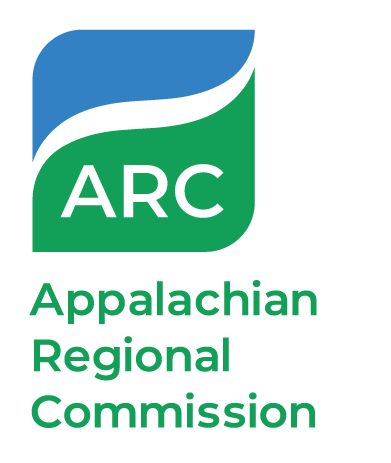Projects
During the two-week research experience, students and teachers conduct short-term research projects under the guidance or ORNL and ORAU mentor scientists. The culmination of this two-week experience is a poster session where the research groups present their research posters to and answer questions from federal and state ARC dignitaries, ORNL and ORAU dignitaries, parents, and friends.
Skip to: Past Academy Projects
2025 Student Projects
-
Empowering Appalachia: Exploring Hydropower with GIS
Access to safe, reliable energy is essential for national security, economic growth, and community well-being. Through this project, students will explore how hydropower can help meet these needs and hazards associated with them. Students will be introduced to Geographic Information Science (GIS), a powerful technology used in fields like environmental science, urban planning, and national security. Using open-source (free) GIS software, students will learn how to identify locations in the Appalachian region that could benefit from new hydropower dams, pinpoint outdated or unsafe dams that may pose risks, and understand the impacts of hydropower. Through hands-on activities, students will work with real-world data including maps of rivers, lakes, population centers, and power grids. They'll gain practical experience and insight into how GIS is used in real-world decision-making and careers across industry, government, and academia.
ORNL Division: Geospatial Science and Human Security
Mentors: Dr. Nagendra Singh
Assistants: Jack Gonzales & Nicolle Di Domenico
Students: Ethan Stritz, Emmamae White, Rosie Orr, Ethan Ahn, Jolie Cronkhite
-
Automating Experiments in Extreme Conditions
With the rise of machine learning and artificial intelligence, the labs of the future will rely on deep multimodal training data taken from real-world observations. Experimental condensed matter physics and materials engineering often require the development of new methods of measuring fundamental properties of matter under extreme conditions, such as those in nuclear reactors or quantum computers. Since it is often impossible to buy equipment capable of making the precise measurements needed under these conditions, the researcher must design and build his/her own experimental systems. This project will explore the development of parameter controlling systems (temperature, gas flow rate, resistivity, etc.) for fundamental science experiments (e.g., synthesis and physical property measurements) based on low-cost, open-source microcontrollers. Students will gain hands-on experience in programming microcontrollers to monitor experimental parameters and to control these parameters using feedback loops. Students will devise their own unique applications for these approaches and create working devices based on their ideas.
ORNL Division: Materials Science and Technology Division and Center for Nanophase Materials
Mentors: Dr. Zac Ward and Dr. Matt Brahlek
Assistants: Deb Mallick
Students: Jensen Fluke, Josh Ramsey, Caspian Coughlin, Ayush Srivastava, Samuel Xiao
-
Modern Computing Concepts for Science
This summer institute introduces the concepts of modern computing for students in science and technology. We begin with the building-blocks of computing: NUMBERS! Since computers are numerical devices, the decimal, octal, hexadecimal, and binary number systems are introduced and used. Computers are devices with both hardware and software components. Hardware is essential to realize a computer design, and so we learn about and manipulate various hardware devices and components found in modern personal computers. We will dissemble and reassemble a personal computer! With computer hardware constraints in mind, we begin learning more about modern personal computer operating systems starting with Microsoft Windows 10. The command line interface (CLI) is introduced to manipulate the computer system. After Windows usage is reinforced, we will install a system that allows us to perform additional tasks on a personal computer. This additional virtualization capability will be provided by VMware Workstation or Virtual Box. In the virtual system, we will load a UNIX/Linux operating system and learn command-line commands and install useful software including the Python programming language. In the Python language, the workshop participants will learn and practice the art and science of programming for science and technology.
ORNL Division: Joint Institute for Computational Sciences
Mentor: Tabitha Samuel
Facilitator: Jerry Sherrod
Assistant: Amber Boyd
Students: Shawn De Pedro, Madelyn Conner, Ananya Madduri, Ethan All, Madelyn Nedimyer, Grant Miller
-
Computational Simulations of Nuclear Reactors
This project focuses on computational simulations of nuclear reactors. These devices supply nearly 20% of the electricity in the US and are the largest source of carbon-free electricity. Students will first learn the physics of nuclear fission, which produces enormous amounts of energy. Next, students will learn the basics of coding in the Python programming language and the computational methods used to simulate reactors. Finally, students will conduct computational experiments to determine which solution methods are most effective, and what materials provide the best shielding from radiation.
ORNL Division: Nuclear Energy and Fuel Cycle Division
Mentors: Jin Whan Bae, Ariel Marquez, Moataz Harb
Students: Isaiah Massengale, Caton Tsao, Dream Kang, William Cooper
-
Robotic Systems and Engineering Development
Robots are used in the industry to protect humans from hazardous environments or when the work involves highly repetitive and precision tasks. The objectives of this project are to (1) expose students to robotic projects underway at ORNL and (2) provide hands-on experience in designing, constructing and programming a small robot. The students will work in groups on similar problems at the Remote Systems Group of ORNL's Fusion Energy Division. The focus of this project is to develop the mechanical and programming skills that are needed to design, build and operate a robot. The student will build a robot that can navigate an obstacle course using various sensors (light, ultrasonic and/or touch). The students will learn which sensors are best suited for which purposes and what logic is appropriate for controlling the robot's trajectory. Students will be using the Lynxmotion Tri-Track Robot and AL5A Robotic Arm for building and testing. The students will also program an actual FANUC Robot arm used in Manufacturing.
ORNL Division: Fusion Energy Division
Mentor: Dr. Adam Carroll, Dr. Adam Aaron, & Dr. Venu Varma
Facilitators: Andy Rayfield
Students: Willany Sayles, Zane Cook, Sarah Collis, Ashlynn Bufford, Deegan Evans, Rachel Lawson
-
Design, Analysis, and Fabrication of Isotope Surrogate Irradiation Experiments
Isotope production at the High Flux Isotope Reactor (HFIR) involves a collaborative effort across multiple facets of STEM. This includes materials science, chemistry, nuclear engineering, and mechanical engineering, all committed to the same purpose of producing potentially life-saving medicines, heat sources for deep space exploration, or bleeding-edge aerospace diagnostic tools. In this project, students will be provided with an in-depth exploration of several facets of this effort, including pellet production, irradiation vehicle design, and data analysis. Students will be invited to participate in the following activities: Experience a lab environment; measure physical properties of isotopic feedstock; collaborate with a team to design an irradiation target vehicle; conduct first-r analysis of that test vehicle; and perform statistical analysis to support qualification of their design(s).
ORNL Division: Radioisotope Science and Technology Division
Mentor: Victor Bautista, Dr. Josh Graves, , Justin Griswold
Students: Caroline Kephart, Chinonyerem Okoro, LillyAnn Spurlock, Isaiah Brunk, Ainsley Good
-
Environmental Systems Science
This workshop focuses on the science, modelling, and communication of environmental systems. Environmental systems science is very complicated, but it is relevant to everyone. Students will develop a better understanding of the science of environmental systems, how it is being investigated, and how to write and talk about it. Importantly, students will be given the freedom to design and execute their own research project. In prior years, participants have developed environmental systems science teaching materials for middle schoolers, and an environmental stewardship program to foster resilience in rural communities.
ORNL Division: Computational Science and Engineering/Communications Office
Mentor: Melissa Dumas
Assistant: Bill Cabage
Facilitator: Ross Toedte
Students: Leelah Bradshaw, Avery Mcnabb, Neve Washburn, Cailey Bowers, Allison Yoste
Past Academy Projects
-
-
Site Selection for Nuclear Modular Reactor
The project introduces students to geographical information science (GIS) and spatial data analysis. Using open-source software the students learn how to use geospatial data to find suitable locations for siting a small modular nuclear reactor (SMR) in the Appalachian region. Students learn how to visualize and analyze various types of geospatial data formats like land use land cover, digital elevation, and population density and use spatial analysis to find areas where a SMR can be sited. The students learn how GIS is used in various applications ranging from urban planning, energy infrastructure to national security.
ORNL Division: Geospatial Science and Human Security
Mentors: Dr. Nagendra Singh
Assistants: Jessica Moehl & Kelly Sims
Students: Braden Bass, Caleb Christman, Annagayle Fishmoore, Elizabeth McNett, Audrey Sears, Rain Bowles
-
Designing Experimental Automation for Extreme Environments
Experimental condensed matter physics and materials engineering often require the development of new methods of measuring fundamental properties of matter under extreme environments. Since it is often impossible to buy equipment capable of making the precise measurements needed under these conditions, the researcher must design and build his/her own experimental systems. This project explores the development of parameter controlling systems (temperature, gas flow rate, resistivity, etc.) for fundamental science experiments (e.g., synthesis and physical property measurements) based on low-cost, open-source microcontrollers. Students gain hands-on experience in programming microcontrollers to monitor experimental parameters and to control these parameters using feedback loops. Students devise their own unique applications for these approaches and create working devices based on their ideas.
ORNL Division: Materials Science and Technology Division
Mentors: Dr. Zac Ward and Dr. Matt Brahlek
Assistants: Jane Chen
Students: Ellie Harrell, Keenan Machi, Lydia Pratt, Jazmin Quiej, Lucas Runyon
-
Modern Computing Concepts for Science
This summer institute introduces the concepts of modern computing for students in science and technology. We begin with the building-blocks of computing: NUMBERS! Since computers are numerical devices, the decimal, octal, hexadecimal, and binary number systems are introduced and used. Computers are devices with both hardware and software components. Hardware is essential to realize a computer design, and so we learn about and manipulate various hardware devices and components found in modern personal computers. We will dissemble and reassemble a personal computer! With computer hardware constraints in mind, we begin learning more about modern personal computer operating systems starting with Microsoft Windows 10. The command line interface (CLI) is introduced to manipulate the computer system. After Windows usage is reinforced, we will install a system that allows us to perform additional tasks on a personal computer. This additional virtualization capability will be provided by VMware Workstation or Virtual Box. In the virtual system, we will load a UNIX/Linux operating system and learn command-line commands and install useful software including the Python programming language. In the Python language, the workshop participants will learn and practice the art and science of programming for science and technology.
ORNL Division: Joint Institute for Computational Sciences
Mentor: Don Reed
Facilitator: Jerry Sherrod
Students: Ihsan Ahmad, Breana Barlow, Heng-Yu Andrew Lee, Juliana Martinez, Kimberly Salinas, Caitlin Walters, Kaidyn Wilder, Ben Moody
-
Computational Simulations of Nuclear Reactors
Nuclear reactor devices supply nearly 20% of the electricity in the US and are the largest source of carbon-free electricity. In the Computational Simulations of Nuclear Reactors project, students learn the physics of nuclear fission, which produces enormous amounts of energy, the basics of coding in the Python programming language, and the computational methods used to simulate reactors. Students conduct computational experiments to determine which solution methods are most effective, and what materials provide the best shielding from radiation.
ORNL Division: Nuclear Energy and Fuel Cycle Division
Mentors: Dr. Elliott Biondo and Dr. Mathew Swinney
Facilitator: Loftin Gerberding
Students: Brandon Henry, Gabe Reese, Hunter Spradlin, Tyler Wiggins, Nathaniel Zuraw
-
Climate Sciences Project
This workshop focuses on the science, modelling, and communication of climate change. Climate change science is very complicated, but it is relevant to everyone. Students will develop a better understanding of the science of climate change, how it is being investigated, and how to write and talk about it. Importantly, students will be given the freedom to design and execute their own research project. In prior years, participants have developed climate science teaching materials for middle schoolers, an environmental stewardship program for rural communities, and a carbon monitoring program for Appalachian regions using NASA databases.
ORNL Division: Computational Science and Engineering/Communications Office
Mentor: Mr. Bill Cabage, Dr. Melissa Dumas
Facilitator: Dr. Ross Toedte
Students: Lahela Erminger, Natalie Mason, Leo Rafael, Cam Ulrich, Ella Whysong, Sara Zameroski
-
Robotic Systems and Engineering Development
Robots are used in the industry to protect humans from hazardous environments or when the work involves highly repetitive and precision tasks. The objectives of this project are to (1) expose students to robotic projects underway at ORNL and (2) provide hands-on experience in designing, constructing and programming a small robot. The students will work in groups on similar problems at the Remote Systems Group of ORNL's Fusion Energy Division. The focus of this project is to develop the mechanical and programming skills that are needed to design, build and operate a robot. The student will build a robot that can navigate an obstacle course using various sensors (light, ultrasonic and/or touch). The students will learn which sensors are best suited for which purposes and what logic is appropriate for controlling the robot's trajectory. Students will be using the Lynxmotion Tri-Track Robot and AL5A Robotic Arm for building and testing. The students will also program an actual FANUC Robot arm used in Manufacturing.
ORNL Division: Fusion Energy Division
Mentor: Dr. Adam Carroll, Dr. Adam Aaron, & Dr. Venu Varma
Facilitators: Andy Rayfield
Students: Kenzie Akins, June Bardash, Aubrey Cornett, Naomi Escobar, Aedan Helms, Robert Trifas
-
Design, Analysis, and Fabrication of Isotope Surrogate Irradiation Experiments
Isotope production at the High Flux Isotope Reactor (HFIR) involves a collaborative effort across multiple facets of STEM. This includes materials science, chemistry, nuclear engineering, and mechanical engineering, all committed to the same purpose of producing potentially life-saving medicines, heat sources for deep space exploration, or bleeding-edge aerospace diagnostic tools. In this project, students are provided with an in-depth exploration of a several facets of this effort, including pellet production, irradiation vehicle design, and data analysis. Students work in a lab environment to measure physical properties of isotopic feedstock; work in a team setting to design an irradiation target vehicle; conduct first-r analysis of that test vehicle; and perform statistical analysis to support qualification of their design(s).
ORNL Division: Radioisotope Science and Technology Division
Mentor: Victor Bautista, Dr. Josh Graves, Grace Power
Students: Harley Dodge, Finn Gallagher, Erika Liu, Sophia McIntire, Landen Zakalowski
-
Physical Properties of Biomass and their Biochar
We delve into the characterization of the physical properties of both biomass and their resulting biochar. With meticulous attention to detail, we scrutinize various properties including but not limited to particle size distribution, density, moisture content, and flowability. By employing a range of analytical techniques, such as an image analyzer, envelope density analyzer, and FT4 powder rheometer, we aim to explore the morphological features of both biomass and biochar samples. This multifaceted approach not only sheds light on the physical transformations that occur during the pyrolysis process but also provides invaluable insights into the potential applications of biochar in diverse fields including agriculture, environmental remediation, and energy production.
ORNL Division: Environmental Science Division
Mentor: Dr. Oluwafemi Oyedeji
Assistant: Robin Clark
Students: River Moyer, Ryan Templeton, Jamie Turner, Crystal Zheng
-
-
-
Designing Experimental Automation for Extreme Environments
Experimental condensed matter physics and materials engineering often require the development of new methods of measuring fundamental properties of matter under extreme environments. Since it is often impossible to buy equipment capable of making the precise measurements needed under these conditions, the researcher must design and build his/her own experimental systems. This project will explore the development of parameter controlling systems (temperature, gas flow rate, resistivity, etc.) for fundamental science experiments (e.g., synthesis and physical property measurements) based on low-cost, open-source microcontrollers. Students will gain hands-on experience in programming microcontrollers to monitor experimental parameters and to control these parameters using feedback loops. Students will devise their own unique applications for these approaches and create working devices based on their ideas.
ORNL Division: Materials Science and Technology Division
Mentors: Zac Ward, Matt Brahlek
Assistants: Jane Chen
Students: Timari Bailey, Dominick dos Santos, Kourtni Jackson, Alexandrea Lundborg
-
Modern Computing Concepts for Science
This summer institute introduces the concepts of modern computing for students in science and technology. We begin with the building-blocks of computing: NUMBERS! Since computers are numerical devices, the decimal, octal, hexadecimal, and binary number systems are introduced and used.
Computers are devices with both hardware and software components. Hardware is essential to realize a computer design, and so we learn about and manipulate various hardware devices and components found in modern personal computers. We will dissemble and reassemble a personal computer!
With computer hardware constraints in mind, we begin learning more about modern personal computer operating systems starting with Microsoft Windows 10. The command line interface (CLI) is introduced to manipulate the computer system. After Windows usage is reinforced, we will install a system that allows us to perform additional tasks on a personal computer. This additional virtualization capability will be provided by VMware Workstation or Virtual Box.
In the virtual system, we will load a UNIX/Linux operating system and learn command-line commands and install useful software including the Python programming language. In the Python language, the workshop participants will learn and practice the art and science of programming for science and technology.
ORNL Division: Joint Institute for Computational Sciences
Mentor: Don Reed
Facilitator: Jerry Sherrod
Students: Dylan Johnson, Ethan Kasdan, Sarah Smith, Emily Welch
-
Computational Investigation of the Monte Carlo Method for Shielding Optimization and Tally Statistics
This project will bring together concepts of nuclear physics, applied math/statistics, and computer science. A simple 1-D Monte Carlo neutron transport code will be used to investigate two basic research questions. First, when solving the Boltzman radiation transport equation using the Monte Carlo method, are batch statistics or history statistics better for dose tallies? Second, what shielding configuration is optimal for reducing radiation dose rate? Both of these questions will be answered by performing shielding optimization on a simple neutron transport problem using Python and Jupyter Notebooks with the 1-D Monte Carlo code mentioned above. Although simple, these research questions show how computational methods are used for nuclear engineering and will give insight into which statistical methods are better for tallies as the nuclear research community moves toward solving very large problems with cutting-edge high-performance supercomputers that take advantage of new GPU architectures.
ORNL Division: Nuclear Energy and Fuel Cycle Division
Mentors: Mathew Swinney, Elliott Biondo
Facilitator: Loftin Gerberding
Students: Robert Bennett, Piper Cook, Logan Cummins, Walker West
-
Climate Sciences Project
This workshop focuses on the science, modelling, and communication of climate change. Climate change science is very complicated, but it is relevant to everyone. Students will develop a better understanding of the science of climate change, how it is being investigated, and how to write and talk about it. Importantly, students will be given the freedom to design and execute their own research project. Students have developed climate science teaching materials for middle schoolers, an environmental stewardship program for rural communities, and a carbon monitoring program for Appalachian regions using NASA databases.
ORNL Division: Computational Science and Engineering/Communications Office
Mentor: Bill Cabage and Melissa Dumas
Facilitator: Ross Toedte
Students: Grecia Avellaneda-Castro, Giselle Hernandez-Castorena, Artemis Rupe, Carter Scaggs, Andrew Whaley
-
Robotic Systems and Engineering Development
Robots are used in the industry to protect humans from hazardous environments or when the work involves highly repetitive and precision tasks. The objectives of this project are to (1) expose students to robotic projects underway at ORNL and (2) provide hands-on experience in designing, constructing, and programming a small robot. The students will work in groups on similar problems at the Remote Systems Group of ORNL's Fusion Energy Division. The focus of this project is to develop the mechanical and programming skills that are needed to design, build, and operate a robot. The student will build a robot that can navigate an obstacle course using various sensors (light, ultrasonic and/or touch). The students will learn which sensors are best suited for which purposes and what logic is appropriate for controlling the robot's trajectory. Students will be using the Lynxmotion Tri-Track Robot and AL5A Robotic Arm for building and testing. The students will also program an actual FANUC Robot arm used in Manufacturing.
ORNL Division: Fusion Energy Division
Mentor: Adam Carroll, Adam Aaron, & Venu Varma
Facilitators: Andy Rayfield, Lane Whiteside
Students: Wren Duckworth, Belle Le Fever, Trace Loveday, Courtney Purves, Aidan Ryan
-
Visualizing and Analyzing Change in Population and Demographics in the Appalachian Region
The project will introduce the students to geographical information science (GIS) and spatial data analysis. Using open-source software the students will learn how to analyze data from the census and create maps of various variables like population, race, age and income levels. Students will learn to analyze how these variables have changed over time and what new resources (schools, hospitals, roads etc.) have been build in the areas where population has grown. The students will learn how GIS is used in various applications ranging from urban planning, energy infrastructure to national security.
ORNL Division: GSHSD
Mentor: Nagendra Singh
Assistants: Jessica Moehl & Bennett Morris
Students: McKenna Adams, Cara Divney, Isabelle Gladson, Emma Thomas, Riley Yates
-
A Demonstration of Surface Tension and Contact Angle
The contact angle of a liquid on a flat surface determines the spreading or wetting properties of the system. This is an essential aspect of liquid flow and adhesion characteristics and is often used in the industry to develop better materials and evaluate product quality. The angle is measured as the angle formed where a liquid or vapor interacts with a solid surface. The liquid generally forms a dome shape, caused by the surface tension of the liquid and its attraction to the surface. In this project, we will demonstrate how contact angle and surface tension change with different materials, such as graphite, stainless steel, vanadium, and glass. We will also show how surface tension affects contact angle by applying different liquids, such as water, ethanol, and ethylene glycol.
ORNL Division: Chemical Science Division
Mentor: Jisue Moon
Students: Silence Karl, Baylee Newman
-
-
-
Comparative Evaluation of Oncogenic protein Hepatocyte Growth Factor (HGF) and its cysteine variants in Human Cells
All biological impacts of HGF in cell proliferation are triggered by binding of HGF to its cell surface receptor, cellular mesenchymal-epidermal transition (c-MET). HGF/c-MET signaling induces multifunctional cellular responses. Dysregulation of HGF/c-MET signaling cascade can lead to tumorigenesis by transforming normal cells to tumor cells. We mutated core cysteine residues in HGF and then will evaluate stability of individual variants in protein level. We will also determine the phosphorylation level of c-MET (p-MET) in human cells which is a part of signal transduction pathway.
Majority of the cancers show hyperphosphorylation of pMET and we would like to elucidate if these mutations could abrogate the phosphorylation level in c-MET. The results from the project will help us to dissect the role for the specific cysteine-residues in HGF/c-MET interaction and could set the stage for future therapies that selectively disrupt the MET signaling cascade with limited off-target effects in tumors overexpressing HGF/c-MET.
ORNL Division:
Bioscience DivisionMentors:
Kuntal DeStudents:
Lexie Unger
Lalitha Tadikonda
Griffin Milford
Nathan Brusseau -
Designing Experimental Automation for Extreme Environments
Students will gain hands-on experience in programming microcontrollers to monitor experimental parameters and to control these parameters using feedback loops. The devices built during this process will then be used in real experiments observing electron conduction characteristics of single crystal correlated oxide films in varied environments.
Experimental condensed matter physics and materials engineering often require the development of new methods of measuring fundamental properties of matter under extreme environments. Since it is often impossible to buy equipment capable of making the precise measurements needed under these conditions, the researcher must design and build his/her own experimental systems. This project will explore the development of parameter controlling systems (temperature, gas flow rate, resistivity, etc.) for fundamental science experiments (e.g., thin film deposition, physical property measurement) based on low-cost, open-source microcontrollers. Students will gain hands-on experience in programming microcontrollers to monitor experimental parameters and to control these parameters using feedback loops. The devices built during this process will then be used in real experiments observing electron conduction characteristics of single crystal correlated oxide films in varied environments.
ORNL Division:
Materials Science and Technology DivisionMentor: Zac Ward
Assistants: Matt Brahlek, Yun-yi Pai, Rob Moore
Students:
Carter Rogers
Wade Groff
Anabelle Esmond
McKayla Beldyk -
Nozzle design for single phase and multiphase flow for electronics cooling
This project would be using jet impingement (single phase and multi-phase) to cool hot objects which in our case would be power electronics device. The scope of the project would be to design different nozzle shape/design of nozzles to create different types of jet flow.
Initially the scope of the work would be to design in CAD software (soildworks) and later use 3D printing facility to generate the design. Later we would use simulation software COMSOL or anything available to model the flow if we can manage time after our first step of the work. Main objective of this project would be designing a nozzle which would create jet flow to cool the electronics and the pressure drop of the flow would be not smaller (within certain range).
Step 1: Literature review and brainstorming for the in initial design of nozzles
Step 2: analyze the merit/demerits of each design and reduce the design options
Step 3: Develop a CAD geometry of the nozzle design (one or two depending on how many designs we choose)
Step 4: Do the flow analysis of the particular design using a CFD software
Step 5: Explore how we can print it by 3D printer, choose right material for doing so and go for it.
ORNL Division: Building and Transportation Science Division
Mentor: Himel Barua
Facilitator: Loftin Gerberding
Students:
Chris Baez
TJ Carroll
Vanessa Lay
Chloe Kirk -
Modern Computing Concepts for Science
This summer Academy introduces the concepts of modern computing for students in science and technology. We begin with the building-blocks of computing: NUMBERS! Since computers are numerical devices, the decimal, octal, hexadecimal, and binary number systems are introduced and used.
Computers are devices with both hardware and software components. Hardware is essential to realize a computer design, and so we learn about and manipulate various hardware devices and components found in modern personal computers. We will dissemble and reassemble a personal computer!
With computer hardware constraints in mind, we begin learning more about modern personal computer operating systems starting with Microsoft Windows 10. The command line interface (CLI) is introduced to manipulate the computer system. After Windows usage is reinforced, we will install a system that allows us to perform additional tasks on a personal computer. This additional virtualization capability will be provided by VMware Workstation or Virtual Box.
In the virtual system, we will load a UNIX/Linux operating system and learn command-line commands and install useful software including the Python programming language. In the Python language, the workshop participants will learn and practice the art and science of programming for science and technology.
ORAU Division: Joint Institute for Computational Sciences
Mentor: Don Reed
Facilitator: Jerry Sherrod
Students:
Jamion Carter Jr
Jeffrey Eubanks
Chloe Alberti
Reagan Raffo
Leah Scott
Karrina Finley -
Computational Investigation of the Monte Carlo Method for Shielding Optimization and Tally Statistics
This project will bring together concepts of nuclear physics, applied math/statistics, and computer science. A simple 1-D Monte Carlo neutron transport code will be used to investigate two basic research questions.
First, when solving the Boltzman radiation transport equation using the Monte Carlo method, are batch statistics or history statistics better for dose tallies? Second, what shielding configuration is optimal for reducing radiation dose rate? Both questions will be answered by performing shielding optimization on a simple neutron transport problem using Python and Jupyter Notebooks with the 1-D Monte Carlo code mentioned above. Although simple, these research questions show how computational methods are used for nuclear engineering and will give insight into which statistical methods are better for tallies as the nuclear research community moves toward solving very large problems with cutting-edge high-performance supercomputers that take advantage of new GPU architectures.
ORNL Division: Nuclear Energy and Fuel Cycle Division
Mentor: Tara Pandya
Students:
Aislinn Hamilton
Nadia Robinson
Tristan Razote
Zach Starnes -
Climate Sciences Project
This workshop focuses on the science, modelling, and communication of climate change. Climate Systems Science (CSS) holds unique challenges in both formal and informal educational settings. CSS is a multi-science at the crossroads of numerous fundamental sciences such as chemistry and physics, thus requiring special skills of its scientists, educators, and communicators. Furthermore, CSS is a socio-scientific topic and is therefore more than a science issue, precipitating vastly different social framings.
Climate Systems Science (CSS) holds unique challenges in both formal and informal educational settings. CSS is a multi-science at the crossroads of numerous fundamental sciences such as chemistry and physics, thus requiring special skills of its scientists, educators, and communicators. Furthermore, CSS is a socio-scientific topic and is therefore more than a science issue, precipitating vastly different social framings.
This workshop focuses on the science, modelling, and communication of climate change. Climate change science is very complicated, but it is relevant to everyone. Students will develop a better understanding of the science of climate change, how it is being investigated, and how to write and talk about it. Importantly, students will be given the freedom to design and execute their own research project. Students have developed climate science teaching materials for middle schoolers, an environmental stewardship program for rural communities, and a carbon monitoring program for Appalachian regions using NASA databases.
ORNL Divisions:
Computational Science and Engineering Division
Communications OfficeMentors: Melissa Allen (Computational Science and Engineering Division) and Bill Cabage (Communications Office)
Facilitator: Ross Toedte
Students:
Josh Wang
Emma Duffer
Cas Lennon-Puthoff
Tori Teague
Eyrin Kim
Robey Hudson -
Robotic Systems and Engineering Development
Robots are used in the industry to protect humans from hazardous environments or when the work involves highly repetitive and precision tasks. The objectives of this project are to (1) expose students to robotic projects underway at ORNL and (2) provide hands-on experience in designing, constructing, and programming a small robot. The students will work in groups on similar problems at the Remote Systems Group of ORNL's Fusion Energy Division.
The focus of this project is to develop the mechanical and programming skills that are needed to design, build, and operate a robot. The student will build a robot that can navigate an obstacle course using various sensors (light, ultrasonic and/or touch). The students will learn which sensors are best suited for which purposes and what logic is appropriate for controlling the robot's trajectory. Students will be using the Lynxmotion Tri-Track Robot and AL5A Robotic Arm for building and testing. The students will also program an actual FANUC Robot arm used in Manufacturing.
ORAU Division: Fusion Energy Division
Mentors: Venugopal Varma, Adam Aaron, and Adam Carroll
Facilitators: Andy Rayfield and Curt Holmes
Students:
Isaac Suytrigg
Kailee Moore
Haley Orr
Andrew Quade
Emily Ford
Jake Langlois
Ryleigh Larkin
Toby Cox
-
-
-
Climate Systems Science, Modeling, and Communication
This workshop focuses on science and communication about climate change. Science mentors lead activities that help participants understand and learn about the complexities of climate change science, findings from climate modelling projects and experiments, and the collection, processing, and analysis of scientific data.
Communications mentors guide participants in talking about and writing about their understandings of climate change science with different audiences in mind. Examples of science misconceptions, disinformation, and poor communication will be diagnosed and remedied. Experts in related fields such as materials science, appliance efficiency, building design, and audio/video/data technology discuss their respective connections to climate change science. In summary, this workshop is for participants learning about climate change science, conducting their own climate experiments in their home communities, confidently communicating what they know about the science, and using their knowledge and skills in the future.
ORNL Division:
Computational Science and Engineering Division
Communications OfficeMentors:
Melissa Allen, Computational Science and Engineering Division
Bill Cabage, Communications OfficeFacilitator: Ross Toedte
Students:
Mallory Bane
Sydney Burns
Hazel Chmiel
Peyton Deckard
Hudson Reynolds
Matthew Wehler -
Computing: The Complete Process
Learn about the complete process of computing this summer! We begin with the electricity that powers all computers in 2021, learn about the electronic components found in all computers (the “chips” and circuits), and the various major parts of a computer.
After the hardware is covered, we learn about the programs that control the computer itself: The Operating System with both Windows and Linux. After the computer, we will learn about the networks that link computers together throughout a house, a building, cities, countries, and the world. Finally, we must protect our computers from “hackers” and “malware” by learning about cyber security!
ORNL Division:
Joint Institute for Computational ScienceMentors:
Bobby WhittenFacilitator: Jerry Sherrod
Students:
India Ingram
Chance Loveday
Preston Ogunwumi
Samuel Park
Emily Tutt -
Designing for Strength: Making the Most of Your 3D prints
Finite deposition modeling (FDM) 3D printing has become incredibly popular due to the expiration of key patents governing the technology.
A cheap FDM printer has gone from $20k to $200 in less than two decades, quickly leading to the proliferation of FDM 3D printers among hobbyists and engineers alike. While FDM 3D printing has many advantages over more traditional manufacturing techniques, it tends to result in weaker parts than parts made by machining processes. In this class, we will learn how to design and print parts for strength, and along the way you will assemble a 3D printer and learn the basics of computer aided design. We will strength tests parts using a hydraulic press and force gauge and analyze the resulting data. Finally, we will write a report on the practices that result in the strongest 3D printed parts, applying statistical analysis to understand the significance our results.
LANL Divisions: Bioscience (B)
Explosive Science and Shock Physcs (M)
Weapons Stockpile Modernization Division (Q)Mentor: Jacob Yoder (B)
Assistants/Others who will work with students:
Conrad Farnsworth (M)
Amanda Jo Farnsworth (Q)
Remington Bullis (M)Students:
Delta Cole
Evelyn Crall
Ethan Finch
Shiv Patel
Neal Singh
Luciano Spaventa
Aayliana Van Dee
Sydney Vass -
Radiation Biology
The objective of this project is to familiarize the students with different types of radiation and their sources, view the results of radiation exposure through experimentation with eukaryotic organisms including yeast and plants, and explore methods of detecting, assessing, and treating radiation exposure that are being developed at ORNL and other facilities.
The use of ionizing radiation in many industrial, military, and medical devices requires the study of the effects of these types of radiation on living things in order to set limits on exposure and develop protective devices and practices. The objective of this project is to familiarize the students with different types of radiation and their sources, view the results of radiation exposure through experimentation with eukaryotic organisms including yeast and plants, and explore methods of detecting, assessing, and treating radiation exposure that are being developed at ORNL and other facilities.
ORAU Division: ORISE Health Studies
Mentor: Betsy Ellis
Facilitators: Bridget Kennedy
Students:
Shaylyn Avery
Jack Biewer
Elisabeth Groff
Nathaniel Horan
August Mendez-Solis
Vivian Song -
Robotic Systems and Engineering Development
Robots are used in the industry to protect humans from hazardous environments or when the work involves highly repetitive and precision tasks. The objectives of this project are to (1) expose students to robotic projects underway at ORNL and (2) provide hands-on experience in designing, constructing and programming a small robot.
The students will work in four groups on similar problems at the Remote Systems Group of ORNL's Fusion and Materials for Nuclear Systems Division. The focus of this project is to develop the mechanical and programming skills that are needed to design, build and operate a robot. The student will build a robot that can navigate an obstacle course using various sensors (light, ultrasonic and/or touch). The students will learn which sensors are best suited for which purposes and what logic is appropriate for controlling the robot's trajectory.
ORNL Division: Fusion Materials for Nuclear Systems
Mentors: Venugopal Varma, Adam Aaron, Adam Carroll
Facilitators: Andy Rayfield and Curt Holmes
Students:
Abbey Barron
Madyson Cahill
Zachary Hines
Dale Lambert
Daniella Martin
Rishi Soni
Emonie Watson
Isaac Yap -
Spatial Power: Site Suitability Modelling for Smart Neighborhoods
State-of-the-art home energy optimization has led to the development of smart neighborhoods and connected communities to better anticipate energy production and consumption. Smart communities consist of a collection of buildings that have been outfitted with solar photovoltaic (PV) panels, batteries, or grid-connective, energy-efficient building components to better manage energy consumption at the community level.
Retrofitting existing building infrastructure is often cost prohibitive and construction of new infrastructure requires determining the optimal location. In this project, we’ll show how spatial modelling can be used by local governments and utility providers to develop intelligent infrastructure, with the siting of a smart neighborhood as an example case. This project will allow for the introduction of many core concepts underlying geographic information science, including spatial analysis and modeling, network analysis, and human environment interactions. We’ll introduce standard spatial data formats, common GIS tools, and basic open source data collection. At a high-level, this study will be conducted within the jurisdiction of the Tennessee Valley Authority; however, the level of detail and exact location will be determined by students’ abilities and interests.
ORNL Division: National Security Emerging Technologies
Mentors: Jake McKee and Jessica Moehl
Facilitator: Loftin Gerberding
Students:
Alyssia Bleau
Emily Conrad
Zakerie Hubbs
Jungeun (June) Lim
Allan Liu
Davyn Mengeling -
Sensors and Environmental Monitoring: Science and Technology
Advanced sensors and controls programs at ORNL are focused on the design, development, testing and evaluation of next generation sensor devices and sensory systems for real-time situational awareness.
Sensor technologies are enabling new functionalities, products, and markets. Advanced research and development efforts worldwide are focused on next generation sensor technologies that are scalable, economical, and practical. The opportunities enabled by low-cost manufacturing of full-featured sensor platforms range from medicine and biology to energy technology and space science. The project is designed to connect the students with the basic scientific principles that shape the thought of sensors, sensor development, and practical applications. With focus on scientific thinking, problem solving, and hands-on learning, the students will learn about a) sensors to monitor environment, b) sensor selection, c) sensor data collection, and d) intelligent sensing and decision making.
ORAU Division: Materials Science & Technology
Mentor: Pooran Joshi
Students:
Logan Feiler
Eli Johnson
Adithya Madduri
Hayley McCreary
Caleb Rose
Matthew Yao
-
-
2020 Student Projects
-
Climate Systems Science, Modeling, and Communication
This workshop focuses on science and communication about climate change. Science mentors lead activities that help participants understand and learn about the complexities of climate change science, findings from climate modelling projects and experiments, and the collection, processing, and analysis of scientific data.
Communications mentors guide participants in talking about and writing about their understandings of climate change science with different audiences in mind. Examples of science misconceptions, disinformation, and poor communication will be diagnosed and remedied. Experts in related fields such as materials science, appliance efficiency, building design, and audio/video/data technology discuss their respective connections to climate change science. In summary, this workshop is for participants learning about climate change science, conducting their own climate experiments in their home communities, confidently communicating what they know about the science, and using their knowledge and skills in the future.
ORNL Division: Computational Science and Engineering Communications Office
Mentors: Melissa Allen and Bill Cabbage
Facilitator: Ross Toedte
Assistants: Abby Bower
Students: Carson Bartholic, Jacob Fay, Logan Hine, Jordan McCord-Wolbert, Abigail Regan, Piper Seagle, Isaac Sulfridge, Mia Sutton, Stephanie Weisberger
-
Designing for Strength: Making the Most of Your 3D prints
Finite deposition modeling (FDM) 3D printing has become incredibly popular due to the expiration of key patents governing the technology.
A cheap FDM printer has gone from $20k to $200 in less than two decades, quickly leading to the proliferation of FDM 3D printers among hobbyists and engineers alike. While FDM 3D printing has many advantages over more traditional manufacturing techniques, it tends to result in weaker parts than parts made by machining processes. In this class, we will learn how to design and print parts for strength, and along the way you will assemble a 3D printer and learn the basics of computer aided design. We will strength tests parts using a hydraulic press and force gauge and analyze the resulting data. Finally, we will write a report on the practices that result in the strongest 3D printed parts.
LANL Divisions: Bioscience (B) / Explosive Science and Shock Physcs (M) / Weapons Stockpile Modernization Division (Q)
Mentor: Jacob Yoder (B)
Assistants: Conrad Farnsworth (M), Amanda Jo Farnsworth (Q), Remington Bullis (M)
Students: Carina Beebe, Garren Bryant, Rebecca Cazarin, Alyssa McGinnis, Asa O’Neal, Abigail Pendell, Joshua Taylor, Isabella Winegar
-
Physics Modeling for Game Design
This project will focus on giving the students a basic understanding of object oriented software design using C++ for game development in Unreal Engine 4.
By the end of the project students will be expected to know basic C++, be able to collaborate on software projects using industry standard version control platform ‘GitHub’, and be able to develop simple games using Unreal Engine 4. The ultimate goal of the project is for the students to produce a collaborative, multi-level game that showcases a custom, movement capable C++ class with realistic collision modeling.
SNL Division: R&D
Mentors: Skyler Valdez
Students: Zoe Castle, William Coffey, Emilia Germain, Alex Jones, Zoe Leger, Alexa Pace, Dawson Wright
-
Robotic Systems and Engineering Development
Robots are used in the industry to protect humans from hazardous environments or when the work involves highly repetitive and precision tasks. The objectives of this project are to (1) expose students to robotic projects underway at ORNL and (2) provide hands-on experience in designing, constructing and programming a small robot.
The students will work in four groups on similar problems at the Remote Systems Group of ORNL's Fusion and Materials for Nuclear Systems Division. The focus of this project is to develop the mechanical and programming skills that are needed to design, build and operate a robot. The student will build a robot that can navigate an obstacle course using various sensors (light, ultrasonic and/or touch). The students will learn which sensors are best suited for which purposes and what logic is appropriate for controlling the robot's trajectory.
ORNL Division: Fusion Materials for Nuclear Systems
Mentors: Venugopal Varma, Adam Aaron, Adam Carroll
Facilitators: Andy Rayfield and Curt Holmes
Students: Alexander Davies, Jessy Gardner, Ethan Hurley, Brad Marion, Connor Mauro, Gianna Muto, Alexis Steelman, Greta Waitz
-
Spatial Power: Site Suitability Modelling for Smart Neighborhoods
State-of-the-art home energy optimization has led to the development of smart neighborhoods and connected communities to better anticipate energy production and consumption. Smart communities consist of a collection of buildings that have been outfitted with solar photovoltaic (PV) panels, batteries, or grid-connective, energy-efficient building components to better manage energy consumption at the community level.
Retrofitting existing building infrastructure is often cost prohibitive and construction of new infrastructure requires determining the optimal location. In this project, we’ll show how spatial modelling can be used by local governments and utility providers to develop intelligent infrastructure, with the siting of a smart neighborhood as an example case. This project will allow for the introduction of many core concepts underlying geographic information science, including spatial analysis and modeling, network analysis, and human environment interactions. We’ll introduce standard spatial data formats, common GIS tools, and basic open source data collection. At a high-level, this study will be conducted within the jurisdiction of the Tennessee Valley Authority; however, the level of detail and exact location will be determined by students’ abilities and interests.
ORNL Division: National Security Emerging Technologies
Mentors: Jessica Moehl and Jake McKee
Facilitator: Loftin Gerberding
Students: Hannah Allen, Lucas Epperson, India Fears, Jimmy Galloway, Maximilian Krier, Serena Lewis, Brendan Miller, Abigail Shaffer, Jasmine Swirski
-
-
2019 Student Projects
-
Climate Systems Science, Modeling, and Communication
Climate systems science (CSS), holds unique challenges in both formal and informal educational settings. CSS is a multi-science at the crossroads of numerous fundamental sciences such as chemistry and physics, thus requiring special skills of its scientists, educators, and communicators. Furthermore, CSS is a socio-scientific topic and is therefore more than a science issue, precipitating vastly different social framings.
The mentors for this workshop will guide participants in activities that will improve their understanding of the components and complexities of climate systems; the roles of experimentation, data collection, and modelling in CSS research; and design of effective public CSS communication.
ORNL Division: Computational Science and Engineering Communications Office
Mentors: Melissa Allen and Bill Cabbage
Facilitator: Ross Toedte
Students: Kobe Coggins, Desaree Decowski, Edward Humphrey, Emma Kephart, Daniel Maxwell, Makayla Shortt
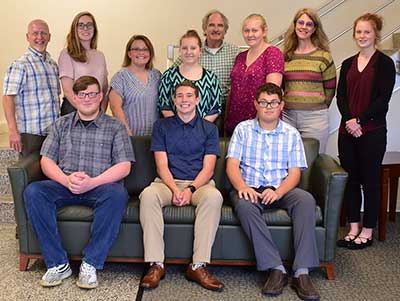
-
Designing Experimental Automation for Extreme Environments
This project will explore the development of parameter controlling systems (temperature, gas flow rate, resistivity, etc.) for fundamental science experiments (e.g., thin film deposition, physical property measurement) based on low-cost, open-source microcontrollers.
Experimental condensed matter physics and materials engineering often require the development of new methods of measuring fundamental properties of matter under extreme environments. Since it is often impossible to buy equipment capable of making the precise measurements needed under these conditions, the researcher must design and build his/her own experimental systems. This project will explore the development of parameter controlling systems (temperature, gas flow rate, resistivity, etc.) for fundamental science experiments (e.g., thin film deposition, physical property measurement) based on low-cost, open-source microcontrollers. Students will have hands-on experience in programming microcontrollers to monitor experimental parameters and to control these parameters using feedback loops. The devices built during this process will then be used in real experiments observing electron conduction characteristics of single crystal correlated oxide films in varied environments.
ORNL Division: Materials Science and Technology
Mentor: Dr. Zac Ward, Materials Science and Technology Division
Assistants:Matt Brahlek, Liz Skoropata, Yogesh Sharma, Alessandro Mazza, Dustin Johnson
Students: Holden Bullock, Lindsey Bush, Carrie Paris, Camden Woodie
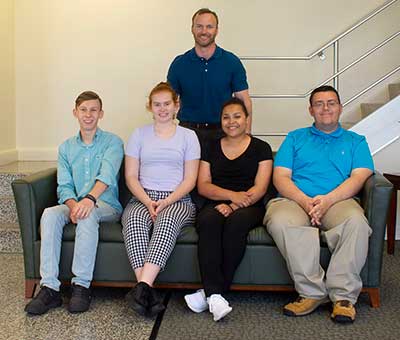
-
Printed Electronics for Low-Cost Sensors and Electronic Systems
The project will expose students to a unique suite of capabilities and expertise at ORNL that are being utilized to accelerate low cost roll-to-roll processing into the production stream.
Roll-to-roll (R2R) processing technology development efforts at ORNL are focused on next generation technologies that are scalable, economical, and practical. The opportunities enabled by low-cost R2R manufacturing of full-featured electronics range from medicine and biology to energy technology and space science. The project will expose students to a unique suite of capabilities and expertise at ORNL that are being utilized to accelerate low cost roll-to-roll processing into the production stream. With focus on flexible and printed electronics technology, the students will learn about a) the role of ink-based printing techniques for the fabrication of light-weight and low-cost sensors on flexible substrates, b) advanced thermal processing techniques to realize printed sensors on low temperature substrates, and c) how to take an idea from concept to manufacturing.
ORNL Division: Materials Science and Technology
Mentors: Pooran Joshi
Assistant: Yongchao Yu
Students: Jadyn Gardner, Sky Green, Elijah Hernandez-Jordan, Joel Roush
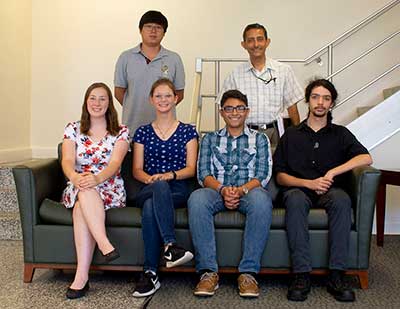
-
Program a Supercomputer
Fun with Supercomputers! The Supercomputer Team will learn about computer hardware, network architecture, and network hardware, and building a PC to use as a server.
Fun with Supercomputers! The Supercomputer Team will learn about computer hardware, network architecture, and network hardware, and building a PC to use as a server. After constructing their own private network, the team will learn about Windows and Linux operating systems and then connect their computers to a real supercomputer housed at ORNL. Each team member will be able to write and run a script program on the supercomputer.
ORNL Division: Joint Institute for Computational Science
Mentor: Bobby Whitten
Facilitator: Jerry Sherrod
Students: Delaney Blankenship, Noah Burnette, David Klinepeter, Michael Kreiss, Katie Krull, Jeanay Luines, Katryna Williams, Wade Wolfer
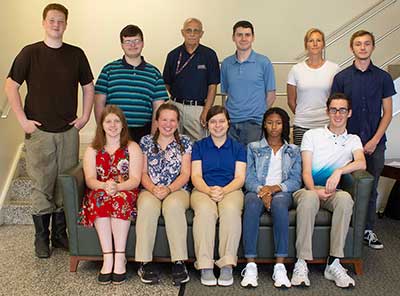
-
Robotic Systems and Engineering Development
Robots are used in the industry to protect humans from hazardous environments or when the work involves highly repetitive and precision tasks. The objectives of this project are to (1) expose students to robotic projects underway at ORNL and (2) provide hands-on experience in designing, constructing and programming a small robot.
Robots are used in the industry to protect humans from hazardous environments or when the work involves highly repetitive and precision tasks. The objectives of this project are to (1) expose students to robotic projects underway at ORNL and (2) provide hands-on experience in designing, constructing and programming a small robot. The students will work in four groups on similar problems at the Remote Systems Group of ORNL's Fusion and Materials for Nuclear Systems Division. The focus of this project is to develop the mechanical and programming skills that are needed to design, build and operate a robot. The student will build a robot that can navigate an obstacle course using various sensors (light, ultrasonic and/or touch). The students will learn which sensors are best suited for which purposes and what logic is appropriate for controlling the robot's trajectory. Students will be using the Lynxmotion Tri-Track Robot and AL5A Robotic Arm for building and testing. The students will also program an actual FANUC Robot arm used in Manufacturing.
ORNL Division: Fusion Materials for Nuclear Systems
Mentors: Venugopal Varma, Adam Aaron, Adam Carroll
Facilitators: Andy Rayfield and Curt Holmes
Students: Isaac Austin, Cody Ferguson, Julie Harris, Anabell Hawkins, Evan Lewis, Hannah Phillips, Ellie Pisula, Anabeth Sharpe, Cory Schwarze, Keegan Torres
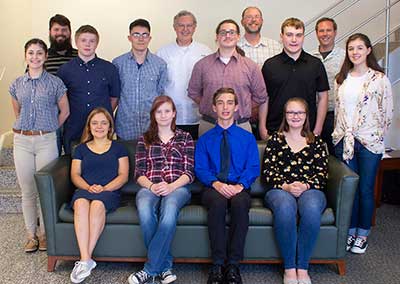
-
Spatial Education: Where Should We Build Tomorrow’s Schools?
In this project, we’ll show how estimates of future populations can be used by local governments to plan new infrastructure, with the siting of a future school as an example case. This project will allow for the introduction of many core concepts underlying geographic information science, including spatial analysis and modeling, network analysis, and +human environment interactions.
High resolution population modeling is a key element in situational awareness planning from measuring the impacts of natural hazards such as hurricanes and sea level rise, to modeling the site suitability for the potential development of new locations of businesses, parks, power plants, and even schools. In this project, we’ll show how estimates of future populations can be used by local governments to plan new infrastructure, with the siting of a future school as an example case. This project will allow for the introduction of many core concepts underlying geographic information science, including spatial analysis and modeling, network analysis, and +human environment interactions. We’ll introduce standard spatial data formats, common GIS tools, and basic open source data collection. Specific study area and level of detail will be determined by students’ abilities and school district location(s).
ORNL Division: National Security Emerging Technologies
Mentors: Jessica Moehl and Jake McKee
Facilitator: Loftin Gerberding
Students: Easton Ball, Jacob Conrad, James Jackson, Sean Moren
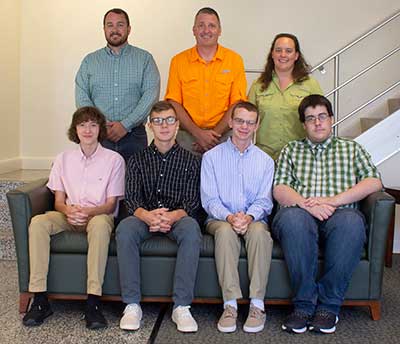
-
-
Student Projects
- Introduction to data visualization
- Robotic Systems and Engineering Development
- Climate Systems Science, Modeling, and Communication
- Build a Supercomputer
- Fiber-Optic Interferometer and its Application to Sensing
- Designing Experimental Automation for Extreme Environments
- Printed Electronics for low-cost Sensors and Electronic Systems
Introduction to data visualization
 A simple hand-on and walk through to build a visual analytic based interface using some existing computing packages. Hopefully we get to develop a dashboard to visual/analyze U.S. Census / ACS data. This is for several reasons.
A simple hand-on and walk through to build a visual analytic based interface using some existing computing packages. Hopefully we get to develop a dashboard to visual/analyze U.S. Census / ACS data. This is for several reasons.- Census data is something that the students would already know a little bit about, so I think it is interesting to them
- All of the pieces that are needed already exist; we will use Shiny Widgets and R programming language for this
PAS input person for your Division: Lisa Gorman
ORNL Division: Computational Sciences and Engineering Division
Mentor: Dr Dalton D. Lunga
Facilitator: Loftin Gerberding
Students: Maegan Adolph, Mariah Bolden, Colton Briand, Shay Snyder
Robotic Systems and Engineering Development
 Robots are used in the industry to protect humans from hazardous environments or when the work involves highly repetitive and precision tasks. The objectives of this project are to (1) expose students to robotic projects underway at ORNL and (2) provide hands-on experience in designing, constructing and programming a small robot. The students will work in four groups on similar problems at the Remote Systems Group of ORNL's Fusion and Materials for Nuclear Systems Division. The focus of this project is to develop the mechanical and programming skills that are needed to design, build and operate a robot. The student will build a robot that can navigate an obstacle course using various sensors (light, ultrasonic and/or touch). The students will learn which sensors are best suited for which purposes and what logic is appropriate for controlling the robot's trajectory. Students will be using the Lynxmotion Tri-Track Robot and AL5A Robotic Arm for building and testing. The students will also program an actual FANUC Robot arm used in Manufacturing.
Robots are used in the industry to protect humans from hazardous environments or when the work involves highly repetitive and precision tasks. The objectives of this project are to (1) expose students to robotic projects underway at ORNL and (2) provide hands-on experience in designing, constructing and programming a small robot. The students will work in four groups on similar problems at the Remote Systems Group of ORNL's Fusion and Materials for Nuclear Systems Division. The focus of this project is to develop the mechanical and programming skills that are needed to design, build and operate a robot. The student will build a robot that can navigate an obstacle course using various sensors (light, ultrasonic and/or touch). The students will learn which sensors are best suited for which purposes and what logic is appropriate for controlling the robot's trajectory. Students will be using the Lynxmotion Tri-Track Robot and AL5A Robotic Arm for building and testing. The students will also program an actual FANUC Robot arm used in Manufacturing.PAS Input Person: Kishia Boyd
ORNL Division: Fusion and Materials for Nuclear Systems
Mentors: Venugopal Varma, Adam Aaron and Adam Carroll
Facilitators: Andy Rayfield and James Burns
Students: Alexander Bowman, Roger Dixon, Andrew Gatesman, Tiana Gold, Baxter Hostetler, Allyssa Ippolito, Kameron McGriff, Mabry Watson
Climate Systems Science, Modeling, and Communication
 Climate systems science (CSS), holds unique challenges in both formal and informal educational settings. CSS is a multi-science at the crossroads of numerous fundamental sciences such as chemistry and physics, thus requiring special skills of its scientists, educators, and communicators. Furthermore, CSS is a socio-scientific topic and is therefore more than a science issue, precipitating vastly different social framings.
Climate systems science (CSS), holds unique challenges in both formal and informal educational settings. CSS is a multi-science at the crossroads of numerous fundamental sciences such as chemistry and physics, thus requiring special skills of its scientists, educators, and communicators. Furthermore, CSS is a socio-scientific topic and is therefore more than a science issue, precipitating vastly different social framings.The mentors for this workshop will guide participants in activities that will improve their understanding of the components and complexities of climate systems; the roles of experimentation, data collection, and modelling in CSS research; and design of effective public CSS communication.
ORNL Division: Computational Science and Engineering Division; Communications Office
Mentors: Melissa Allen, Bill Cabage
Facilitator: Ross J. Toedte
Students: Noah Aiken, Noelle Beswick, Jacob Lord, Kara Williams
Build a Supercomputer
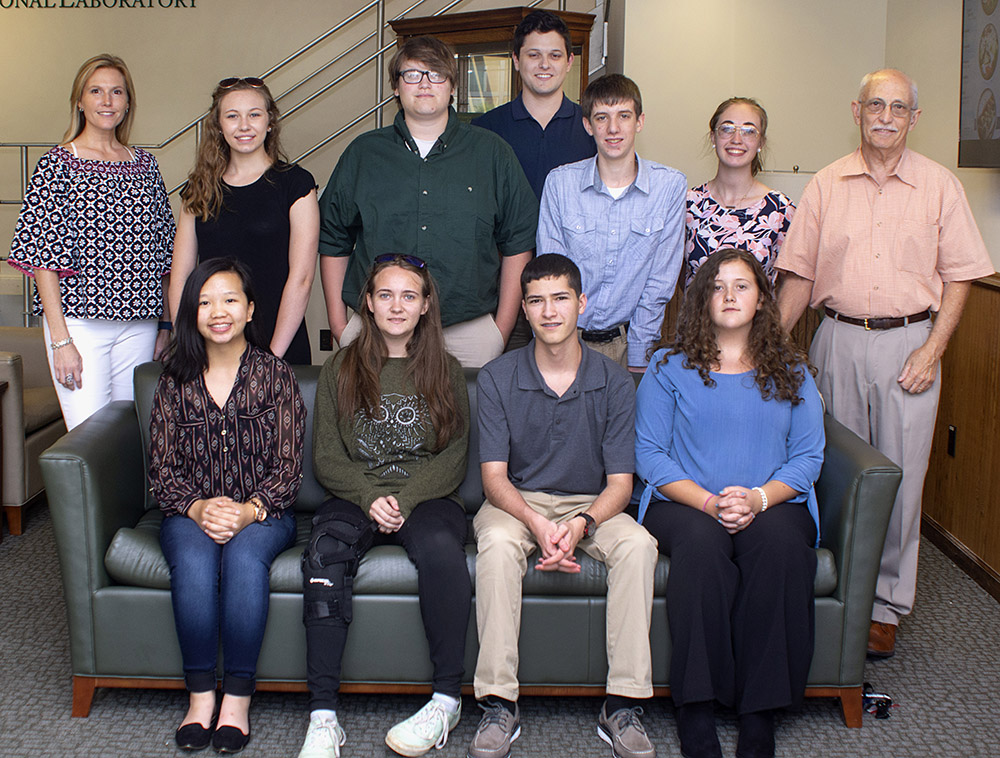 Fun with Supercomputers! The Supercomputer Team will learn about computer hardware, network architecture, and network hardware, and building a PC to use as a server. After constructing their own private network, the team will learn about Windows and Linux operating systems and then connect their computers to a real supercomputer housed at ORNL. Each team member will be able to write and run a script program on the supercomputer.
Fun with Supercomputers! The Supercomputer Team will learn about computer hardware, network architecture, and network hardware, and building a PC to use as a server. After constructing their own private network, the team will learn about Windows and Linux operating systems and then connect their computers to a real supercomputer housed at ORNL. Each team member will be able to write and run a script program on the supercomputer.Joint Institute for Computational Sciences
Mentor: Bobby Whitten
Facilitator: Jerry Sherrod
Assistants: Paul Davis and Jessica Boyd
Students: Lia Evans, Anna Lee, Hannah Little, Eirinn Mangan, Samuel McCullah, James Meyers, Dakota Tiller, Ashley Walker
Fiber-Optic Interferometer and its Application to Sensing
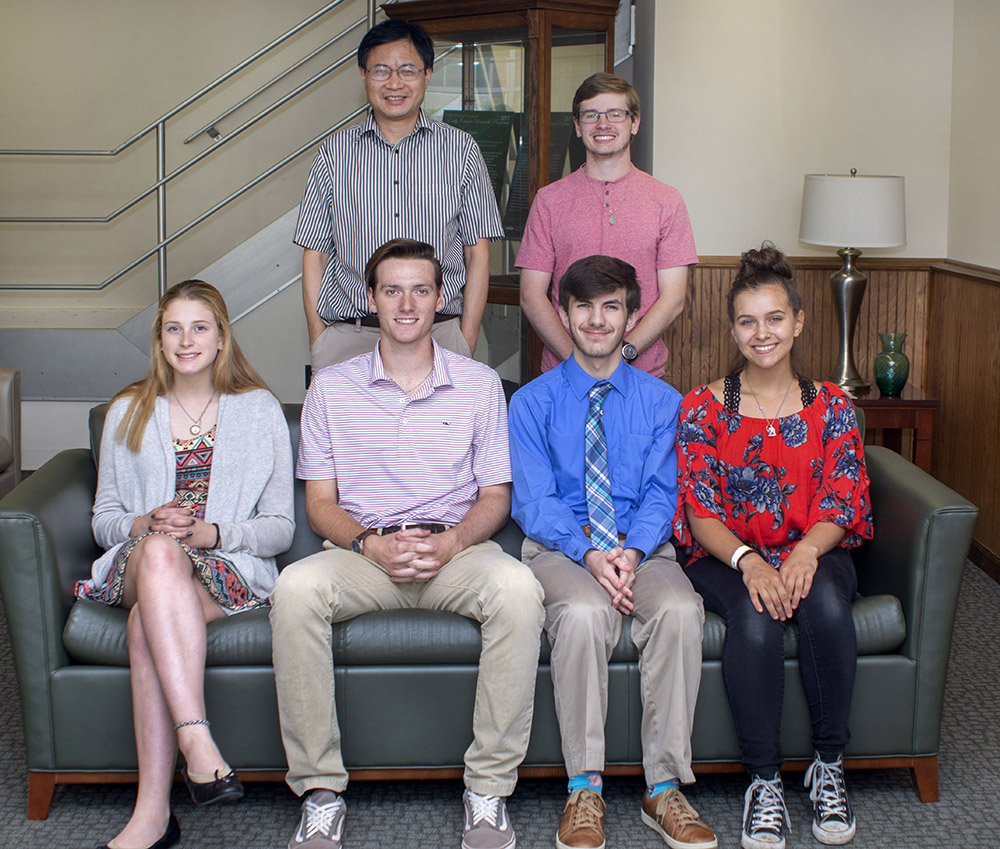 In this project, the participants will study the principle of optical interferometer and build a Mach-Zehnder interferometer using optical fibers. Experiments on light interference with different type of light sources will be conducted. As an example of sensing applications, the fiber-optic interferometer will be used to measure the amplitude and frequency of a vibrating object. Through the project, the participants are expected to gain the basic knowledge of light interference, light transmission through optical fibers, light detection, property of laser, as well as the skill of data acquisition and data processing in a computer.
In this project, the participants will study the principle of optical interferometer and build a Mach-Zehnder interferometer using optical fibers. Experiments on light interference with different type of light sources will be conducted. As an example of sensing applications, the fiber-optic interferometer will be used to measure the amplitude and frequency of a vibrating object. Through the project, the participants are expected to gain the basic knowledge of light interference, light transmission through optical fibers, light detection, property of laser, as well as the skill of data acquisition and data processing in a computer.ORNL Division: Research Accelerator Division
Mentor: Yun Liu
Assistants: Dylan Smith, Bing Qi
Students: Nicholas Craven, Reilly McDowell, Autumn Peck, Elyssa Yonta
Designing Experimental Automation for Extreme Environments
 Experimental condensed matter physics and materials engineering often require the development of new methods of measuring fundamental properties of matter under extreme environments. Since it is often impossible to buy equipment capable of making the precise measurements needed under these conditions, the researcher must design and build his/her own experimental systems. This project will explore the development of parameter controlling systems (temperature, gas flow rate, resistivity, etc.) for fundamental science experiments (e.g., thin film deposition, physical property measurement) based on low-cost, open-source microcontrollers. Students will have hands-on experience in programming microcontrollers to monitor experimental parameters and to control these parameters using feedback loops. The devices built during this process will then be used in real experiments observing electron conduction characteristics of single crystal correlated oxide films in varied environments.
Experimental condensed matter physics and materials engineering often require the development of new methods of measuring fundamental properties of matter under extreme environments. Since it is often impossible to buy equipment capable of making the precise measurements needed under these conditions, the researcher must design and build his/her own experimental systems. This project will explore the development of parameter controlling systems (temperature, gas flow rate, resistivity, etc.) for fundamental science experiments (e.g., thin film deposition, physical property measurement) based on low-cost, open-source microcontrollers. Students will have hands-on experience in programming microcontrollers to monitor experimental parameters and to control these parameters using feedback loops. The devices built during this process will then be used in real experiments observing electron conduction characteristics of single crystal correlated oxide films in varied environments.PAS input person for your Division: Teresa Roe
ORNL Division: Materials Science and Technology Division
Mentor: Zac Ward
Assistants: Qiyang Lu, Liz Skoropata, Changhee Sohn, Yogesh Sharma
Students: A’Shauna Howell, Destiny Hughes, Trenton Teague, Tyler Wade
Printed Electronics for low-cost Sensors and Electronic Systems
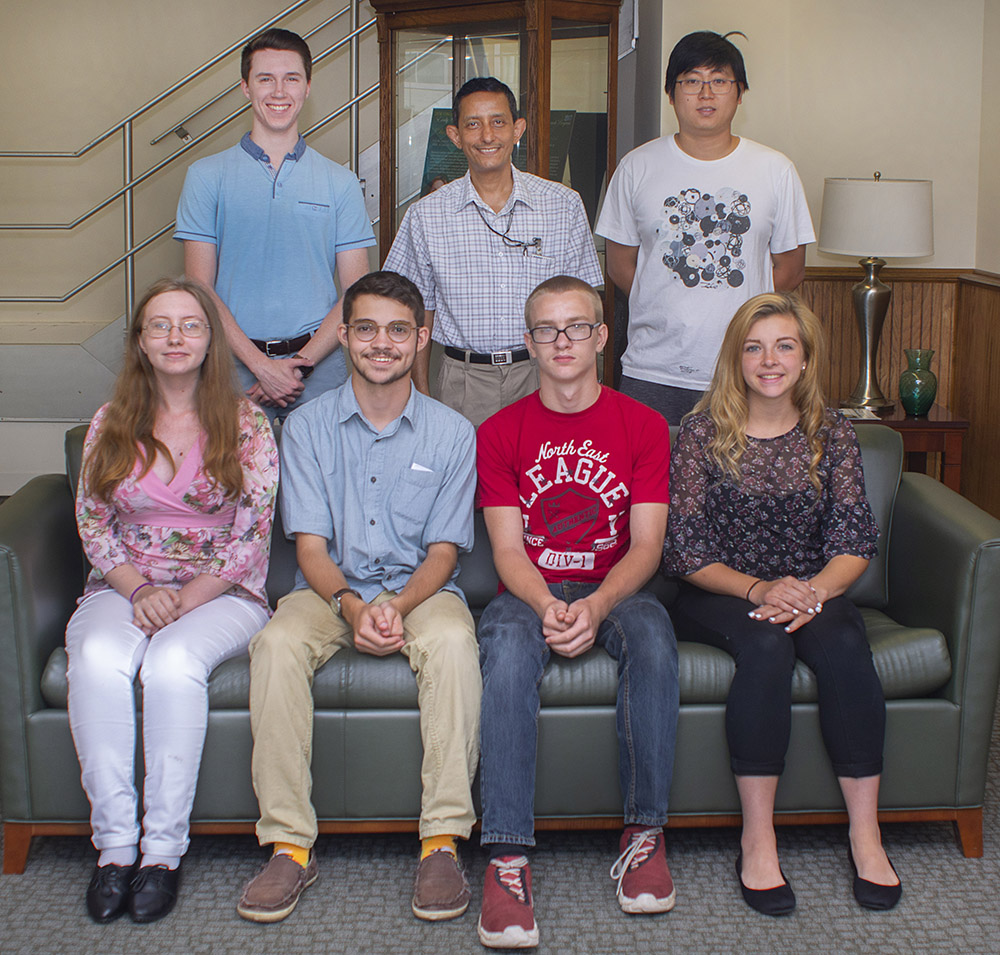 Roll-to-roll (R2R) processing technology development efforts at ORNL are focused on next generation technologies that are scalable, economical, and practical. The opportunities enabled by low-cost R2R manufacturing of full-featured electronics range from medicine and biology to energy technology and space science. The project will expose students to a unique suite of capabilities and expertise at ORNL that are being utilized to accelerate low cost roll-to-roll processing into the production stream. With focus on flexible and printed electronics technology, the students will learn about a) the role of ink-based printing techniques for the fabrication of light-weight and low-cost sensors on flexible substrates, b) advanced thermal processing techniques to realize printed sensors on low temperature substrates, and c) how to take an idea from concept to manufacturing.
Roll-to-roll (R2R) processing technology development efforts at ORNL are focused on next generation technologies that are scalable, economical, and practical. The opportunities enabled by low-cost R2R manufacturing of full-featured electronics range from medicine and biology to energy technology and space science. The project will expose students to a unique suite of capabilities and expertise at ORNL that are being utilized to accelerate low cost roll-to-roll processing into the production stream. With focus on flexible and printed electronics technology, the students will learn about a) the role of ink-based printing techniques for the fabrication of light-weight and low-cost sensors on flexible substrates, b) advanced thermal processing techniques to realize printed sensors on low temperature substrates, and c) how to take an idea from concept to manufacturing.ORNL Division: Materials Science & Technology Division
Mentor: Pooran Joshi
Assistant: Yongchao Yu
Students: Shane Bays, Cierah Manross, Zackery Reynolds, Mercedes Snyder
-
Student Projects
- KBase: Systems Biology Knowledgebase – Bioenergy Crops
- Smart thermochromic Windows
- Introduction to Visualization
- Robotic Systems and Engineering Development
- Introduction to High Altitude Ballooning
- Build a Supercomputer
KBase: Systems Biology Knowledgebase – Bioenergy Crops
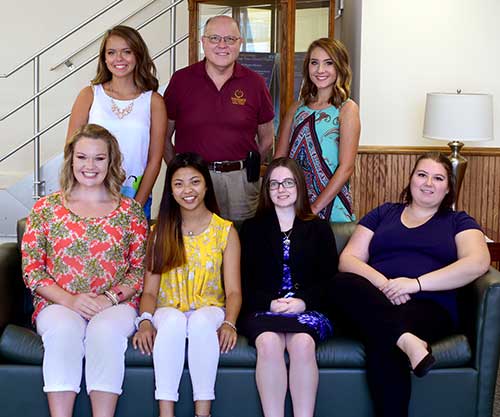 KBase is an integrated software and data platform designed to meet the grand challenge of systems biology – predicting and designing biological function on a range of scales, from the biomolecular to the ecological. Users can perform large-scale analyses and combine multiple lines of evidence to model plant and microbial physiology and community dynamics.
KBase is an integrated software and data platform designed to meet the grand challenge of systems biology – predicting and designing biological function on a range of scales, from the biomolecular to the ecological. Users can perform large-scale analyses and combine multiple lines of evidence to model plant and microbial physiology and community dynamics.The students will study a set of microbes that have been sequenced and uploaded into KBase. The idea will be to map out particular pathways of interest, document all of the pathways, and map which exist in which microbe. We will then see what is possibly predicted and could be validated by inspection. In particular Poplar trees will be studied which is a focused Bioenergy crop.
The students will use KBase to accomplish the objective, learn biology and the use of KBase and provide feedback on the use of KBase to the mentors. The students will also tour a Greenhouse where a Poplar tree is growing and visit a microscopy lab.
ORNL Division: Biosciences Division
Mentors: Bob Cottingham and Ben Allen
Facilitator: Brian Hingerty
Assistants: Meghan Drake, Dan Jacobson, Jenny Morrell-Falvey, Dale Pelletier
Students: Molly Mallicoat, Haythi Myint, Victoria Mitchem, Sharee Riggs, Lydia Sexton, Blaize Stumbo
Smart thermochromic Windows
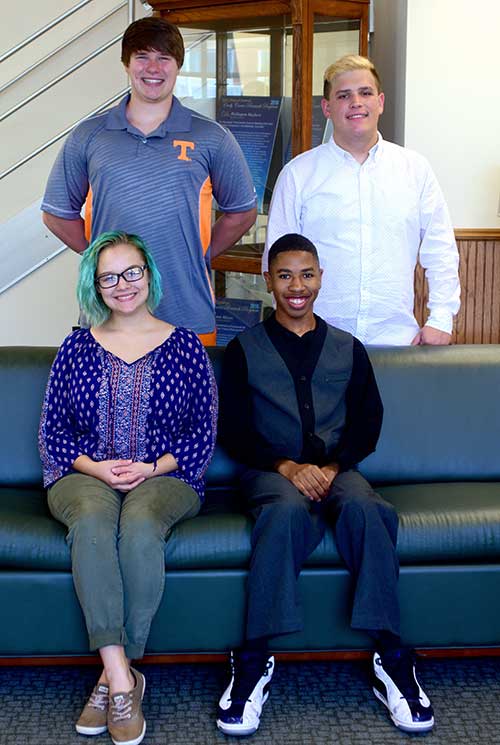 This project will explore the principle of smart windows via thermochromic effect, which dynamically control the amount of light transmission in response to outdoor temperature and solar radiation. A simple photodetector will be fabricated to measure the change in transmittance through a smart window upon exposed to a heat source. Vanadium dioxide thin film coated glass, which undergoes an insulator-to-metal transition (IMT) upon heating near room temperature will be used as a smart window. The IMT behavior will be utilized to adjust tinting with window surface temperature, and the photodetector fabricated will be used to measure the light transmittance change upon IMT.
This project will explore the principle of smart windows via thermochromic effect, which dynamically control the amount of light transmission in response to outdoor temperature and solar radiation. A simple photodetector will be fabricated to measure the change in transmittance through a smart window upon exposed to a heat source. Vanadium dioxide thin film coated glass, which undergoes an insulator-to-metal transition (IMT) upon heating near room temperature will be used as a smart window. The IMT behavior will be utilized to adjust tinting with window surface temperature, and the photodetector fabricated will be used to measure the light transmittance change upon IMT.ORNL Division: Materials Science and Technology Division
Mentor: Honyung Lee
Assistants: Zac Ward, Amanda Huon, Changhee Sohn, Ryan Destales, Yogesh Sharma, John Nichols
Students: Molly Campbell, Martuise Hansbury, Carter Smith, Christopher Towery
Introduction to Visualization
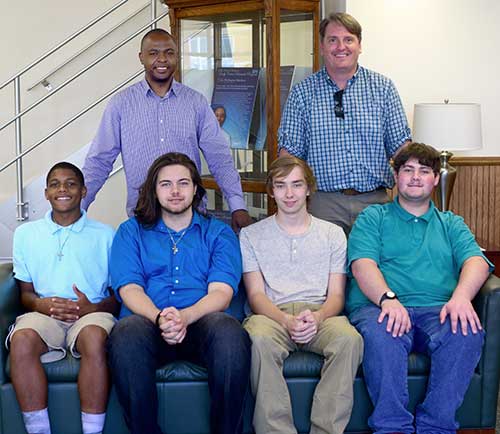 This project is a hands-on walk through to build a visual analytic based interface using some existing computing packages. We will develop a dashboard to visual/analyze U.S. Census / ACS data. We will use Shiny Widgets and R programming language for this.
This project is a hands-on walk through to build a visual analytic based interface using some existing computing packages. We will develop a dashboard to visual/analyze U.S. Census / ACS data. We will use Shiny Widgets and R programming language for this.ORNL Division: Computational Sciences and Engineering Division
Mentor: Dr. Dalton D. Lunga
Facilitator: Loftin Gerberding
Students: Jared Clemons, Caegan Huffman, Dexton Jones, Carltavion Lathan
Robotic Systems and Engineering Development
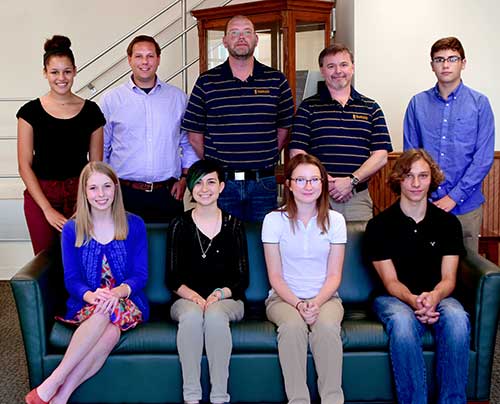 Robots are used in the industry to protect humans from hazardous environments or when the work involves highly repetitive and precision tasks. The objectives of this project are to (1) expose students to robotic projects underway at ORNL and (2) provide hands-on experience in designing, constructing and programming a small robot. The students will work in four groups on similar problems at the Remote Systems Group of ORNL's Fusion and Materials for Nuclear Systems Division. The focus of this project is to develop the mechanical and programming skills that are needed to design, build and operate a robot. The student will build a robot that can navigate an obstacle course using various sensors (light, ultrasonic and/or touch). The students will learn which sensors are best suited for which purposes and what logic is appropriate for controlling the robot's trajectory. Students will be using the Lynxmotion Tri-Track Robot and AL5A Robotic Arm for building and testing. The students will also program an actual FANUC Robot arm used in Manufacturing.
Robots are used in the industry to protect humans from hazardous environments or when the work involves highly repetitive and precision tasks. The objectives of this project are to (1) expose students to robotic projects underway at ORNL and (2) provide hands-on experience in designing, constructing and programming a small robot. The students will work in four groups on similar problems at the Remote Systems Group of ORNL's Fusion and Materials for Nuclear Systems Division. The focus of this project is to develop the mechanical and programming skills that are needed to design, build and operate a robot. The student will build a robot that can navigate an obstacle course using various sensors (light, ultrasonic and/or touch). The students will learn which sensors are best suited for which purposes and what logic is appropriate for controlling the robot's trajectory. Students will be using the Lynxmotion Tri-Track Robot and AL5A Robotic Arm for building and testing. The students will also program an actual FANUC Robot arm used in Manufacturing.ORNL Division: Fusion and Materials for Nuclear Systems
Mentors: Venugopal Varma, Adam Aaron and Adam Carroll
Facilitators: Andy Rayfield and James Burns
Students: Daniel Bohl, Joseph Coffey, Gabriella Fye, Kaitlyn Griffin, Elizabeth Krizmanich, Kiarra McCloud
Introduction to High Altitude Ballooning
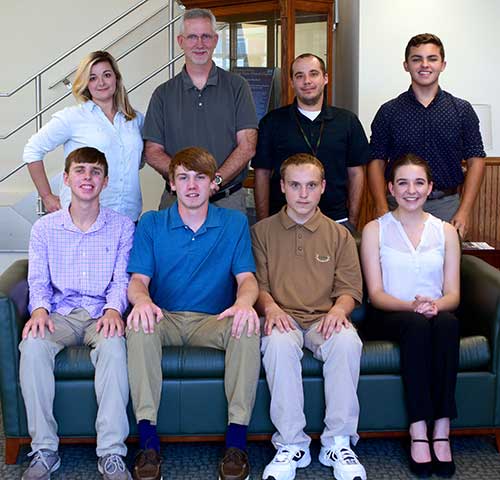 Students will learn about High Altitude Ballooning! In this class, we will learn why we send balloons into the stratosphere and what we can learn from them. Students will learn what a payload is and how to build one along with the necessary tools involved. In the second week, students will be launching a balloon at Pellissippi State Community College where they will learn to setup and launch a balloon into the stratosphere! We will also learn how to run simulations determining where the balloon lands and how to retrieve them. Lastly, we will go over how the students can start their own balloon project or club in their local school and communities.
Students will learn about High Altitude Ballooning! In this class, we will learn why we send balloons into the stratosphere and what we can learn from them. Students will learn what a payload is and how to build one along with the necessary tools involved. In the second week, students will be launching a balloon at Pellissippi State Community College where they will learn to setup and launch a balloon into the stratosphere! We will also learn how to run simulations determining where the balloon lands and how to retrieve them. Lastly, we will go over how the students can start their own balloon project or club in their local school and communities.Joint Institute for Computational Sciences
Mentor: Robert Whitten
Facilitator: Nick Csercsevitz
Assistants: Sarah Graham and Seth Giles
Students: Marissa Brown, Ben Culp, Isaac Fugate, Jared Wilson, Joseph Woods
Build a Supercomputer
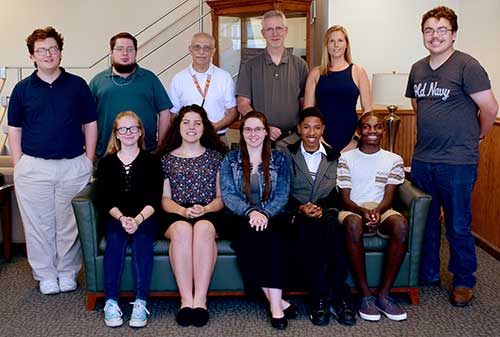 Students will build a supercomputer! Well, almost. Supercomputers typically use thousands of processors running in parallel to solve problems in science, finance, and other areas. They will build a smaller supercomputer to gain insight and understanding in how supercomputers are organized and then how to program them. Students will build and use software to configure a Beowulf cluster using ordinary computers. Areas that will be covered during this project are:
Students will build a supercomputer! Well, almost. Supercomputers typically use thousands of processors running in parallel to solve problems in science, finance, and other areas. They will build a smaller supercomputer to gain insight and understanding in how supercomputers are organized and then how to program them. Students will build and use software to configure a Beowulf cluster using ordinary computers. Areas that will be covered during this project are:- Computing basics
- Computer networking
- Linux operating system
- Computer programming
Students will be required to answer the research question: "In what year would the supercomputer we build be considered the world's fastest supercomputer?"
Joint Institute for Computational Sciences
Mentor: Robert Whitten
Facilitator: Jerry Sherrod
Assistants: Paul Davis and Jessica Boyd
Students: Lilyanna Cope, Anna Cristini, Donald Hansbury, Langdon Messer, Shawn Sexton, Laramie Toliver, Leeanne Williams
-
Student Projects
- Measuring the force and energy imparted by a high heat flux plasma
- Magnetic levitation
- Introduction to Visualization
- Robotic Systems and Engineering Development
- Build a Supercomputer
Measuring the force and energy imparted by a high heat flux plasma
 The Prototype Material Plasma Exposure Experiment (Proto-MPEX) is a linear, magnetically confined plasma production device, utilizing a helicon antenna. The plasma column interacts with a material target at the end of the device, creating plasma-material interaction conditions that are relevant to the conditions that are expected in future fusion reactors. Moreover, helicon antenna plasma sources have been proposed as propulsion devices for spacecraft.
The Prototype Material Plasma Exposure Experiment (Proto-MPEX) is a linear, magnetically confined plasma production device, utilizing a helicon antenna. The plasma column interacts with a material target at the end of the device, creating plasma-material interaction conditions that are relevant to the conditions that are expected in future fusion reactors. Moreover, helicon antenna plasma sources have been proposed as propulsion devices for spacecraft.It has been observed that in some circumstances the Proto-MPEX plasma exerts sufficient force on the target plate to cause the target to move/recoil. The ARC students will help devise and implement a ballistic target/probe which will be inserted into the plasma. The probe response will be calibrated by the students prior to insertion, using scales, thermocouples, accelerometers, and fast camera imaging. The project will culminate by inserting the ballistic probe into Proto-MPEX plasmas and measuring the force that is exerted on it, as a function of the helicon power of the plasma.
ORNL Division: Fusion & Materials for Nuclear Systems
Mentor: Theodore Biewer
Assistants: Guin Shaw, Holly Ray, and Missy Showers
Students: Caleb Cantrell, Jared Klemm, Alex Musick, Garett Nunley, Jennifer Salazar Sanchez, Daisy Sawyer
Magnetic levitation
 This project will explore the principle of magnetic levitation, which utilizes magnetic fields to suspend an object in the air supporting materials to withstand the gravitational force. Assembly of a magnetic rail will be conducted to explore the magnetic levitation phenomenon with an oxide-based high Tc superconductor.
This project will explore the principle of magnetic levitation, which utilizes magnetic fields to suspend an object in the air supporting materials to withstand the gravitational force. Assembly of a magnetic rail will be conducted to explore the magnetic levitation phenomenon with an oxide-based high Tc superconductor.ORNL Division: Materials Science and Technology Division
Mentor: Ho Nyung Lee
Assistants: Zac Ward, Tony Wong, John Nichols, and Ryan Desautels
Students: Cole Brewer, Patrick Lawson, Jade Noah, Lexie Paxton
Introduction to Visualization
 A simple hand-on and walk through to build a visual analytic based interface using some existing computing packages. We will develop a dashboard to visual/analyze U.S. Census / ACS data.
A simple hand-on and walk through to build a visual analytic based interface using some existing computing packages. We will develop a dashboard to visual/analyze U.S. Census / ACS data.ORNL Division: Computational Sciences and Engineering Division
Mentor: Dalton D. Lunga
Students: Austin Herman, Derek Hutchinson, Austin Selman, Christian Sharpe
Robotic Systems and Engineering Development
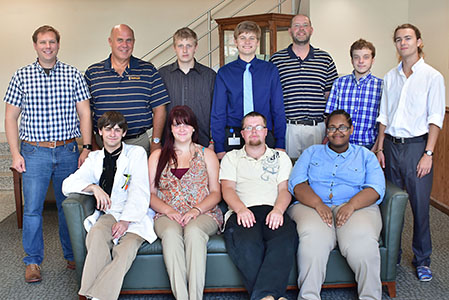 Robots are used in the industry to protect humans from hazardous environments or when the work involves highly repetitive and precision tasks. The objectives of this project are to (1) expose students to robotic projects underway at ORNL and (2) provide hands-on experience in designing, constructing and programming a small robot. The students will work in four groups on similar problems at the Remote Systems Group of ORNL's Fusion and Materials for Nuclear Systems Division. The focus of this project is to develop the mechanical and programming skills that are needed to design, build and operate a robot. The student will build a robot that can navigate an obstacle course using various sensors (light, ultrasonic and/or touch). The students will learn which sensors are best suited for which purposes and what logic is appropriate for controlling the robot's trajectory. Students will be using the Lynxmotion Tri-Track Robot and AL5A Robotic Arm for building and testing. The students will also program an actual FANUC Robot arm used in Manufacturing.
Robots are used in the industry to protect humans from hazardous environments or when the work involves highly repetitive and precision tasks. The objectives of this project are to (1) expose students to robotic projects underway at ORNL and (2) provide hands-on experience in designing, constructing and programming a small robot. The students will work in four groups on similar problems at the Remote Systems Group of ORNL's Fusion and Materials for Nuclear Systems Division. The focus of this project is to develop the mechanical and programming skills that are needed to design, build and operate a robot. The student will build a robot that can navigate an obstacle course using various sensors (light, ultrasonic and/or touch). The students will learn which sensors are best suited for which purposes and what logic is appropriate for controlling the robot's trajectory. Students will be using the Lynxmotion Tri-Track Robot and AL5A Robotic Arm for building and testing. The students will also program an actual FANUC Robot arm used in Manufacturing.ORNL Division: Fusion and Materials for Nuclear Systems
Mentors: Venugopal Varma, Adam Aaron and Adam Carroll
Facilitators: Carl Mallette and Andy Rayfield
Students: Tanner Bailey, Jarrett Bostic, Corey Bray, Tristin Brewer, Bryan Epperson, Niah Ingram, Amber Johnson, Alijah Lawson, Andrea Morgan, Gavin Nelson, Joe Palmateer, Ally Will
Build a Supercomputer
 Students will build a supercomputer! Well, almost. Supercomputers typically use thousands of processors running in parallel to solve problems in science, finance, and other areas. They will build a smaller supercomputer to gain insight and understanding in how supercomputers are organized and then how to program them. Students will build and use software to configure a Beowulf cluster using ordinary computers. Areas that will be covered during this project are:
Students will build a supercomputer! Well, almost. Supercomputers typically use thousands of processors running in parallel to solve problems in science, finance, and other areas. They will build a smaller supercomputer to gain insight and understanding in how supercomputers are organized and then how to program them. Students will build and use software to configure a Beowulf cluster using ordinary computers. Areas that will be covered during this project are:- Computing basics
- Computer networking
- Linux operating system
- Computer programming
Project review and summary
Students will be required to answer the research question: "In what year would the supercomputer we build be considered the world's fastest supercomputer?" Students will be given classroom-style lectures in addition to hands-on assignment to enforce topics discussed.
Joint Institute for Computational Sciences
Mentor: Robert Whitten
Facilitator: Jerry Sherrod
Assistants: Nick Csercsevits and Clinton Carbonell
Students: Andrea Jordan, Nichole Moore, Rob Perry, II, Alaric Scott, Winter Sparacin, Chaz Weeks, Rachel Yoe, Christian York
-
Student Projects
- Application of Diagnostic Techniques for Measurements on the Prototype-Material Plasma Exposure Experiment (PROTO-MPEX)
- Uniformity of Thermal Aging of I&C Cable Insulation in Current Nuclear Power Plants
- Design of Novel Polymeric Materials Using Computer Simulation
- Heterologous expression of mgsD to identify potential adaptation to salt stress
- Magnetic Levitation
- Robotic Systems and Engineering Development
- Build a Supercomputer
Application of Diagnostic Techniques for Measurements on the Prototype-Material Plasma Exposure Experiment (PROTO-MPEX)
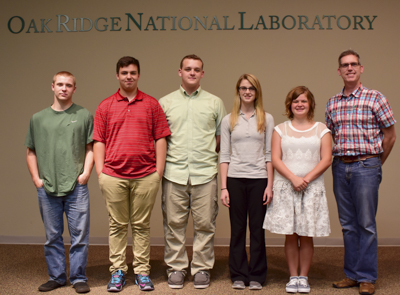 Proto-MPEX is a linear device that uses magnetic fields to confine plasmas and direct them onto material targets, simulating conditions that will be found in future fusion reactors. The students will be introduced to a variety of techniques which are used to make measurements from plasma discharges, including survey spectroscopy, Doppler spectroscopy, filter spectroscopy, infra-red imaging, thermocouples, visible camera imaging, and probes. Students will examine data from computer terminals, both from a data archive and live, as the Proto-MPEX device operates. Students will assemble a database of measurements and look for trends.
Proto-MPEX is a linear device that uses magnetic fields to confine plasmas and direct them onto material targets, simulating conditions that will be found in future fusion reactors. The students will be introduced to a variety of techniques which are used to make measurements from plasma discharges, including survey spectroscopy, Doppler spectroscopy, filter spectroscopy, infra-red imaging, thermocouples, visible camera imaging, and probes. Students will examine data from computer terminals, both from a data archive and live, as the Proto-MPEX device operates. Students will assemble a database of measurements and look for trends.ORNL Division: Fusion & Materials for Nuclear Systems
Mentor: Theodore Biewer
Students: KC Baldwin, Jackson Crouse Powers, Randi Hardin, Sylas Johnson, Ava McCleese
Uniformity of Thermal Aging of I&C Cable Insulation in Current Nuclear Power Plants
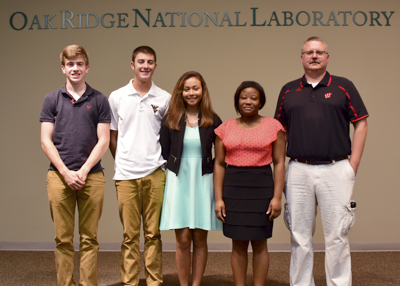 For the aging fleet of nuclear reactors providing power in the US, license renewal is an important step toward extending the operating lifetime of these reactors. However in order to gain approval from the US Nuclear Regulatory Commission, each reactor must demonstrate knowledge through modeling and validations that the infrastructure will continue to operate safely. The cable insulation in instrument and control (I&C) and power cables is an issue that requires cable aging data on existing insulations that are harvested from reactors and models to project performance out to a 60 to 80 year operating lifetime. This project would involve the electrical and mechanical characterization of cable insulation samples that have been exposed to thermal aging. Several different cable samples will be exposed to air at different temperatures between 60 ̊C to 120 ̊C and the jacket and insulation materials of these cables will be evaluated in order to determine the effectiveness of a cable indenter to detect material changes along the length. This information will be part of an effort to build an effective knowledge base for use by those in the nuclear reactor operator community as well as the NRC, DOE, and EPRI.
For the aging fleet of nuclear reactors providing power in the US, license renewal is an important step toward extending the operating lifetime of these reactors. However in order to gain approval from the US Nuclear Regulatory Commission, each reactor must demonstrate knowledge through modeling and validations that the infrastructure will continue to operate safely. The cable insulation in instrument and control (I&C) and power cables is an issue that requires cable aging data on existing insulations that are harvested from reactors and models to project performance out to a 60 to 80 year operating lifetime. This project would involve the electrical and mechanical characterization of cable insulation samples that have been exposed to thermal aging. Several different cable samples will be exposed to air at different temperatures between 60 ̊C to 120 ̊C and the jacket and insulation materials of these cables will be evaluated in order to determine the effectiveness of a cable indenter to detect material changes along the length. This information will be part of an effort to build an effective knowledge base for use by those in the nuclear reactor operator community as well as the NRC, DOE, and EPRI.ORNL Division: Fusion and Materials for Nuclear Systems Division
Mentor: Robert Duckworth
Students: Nicole Broyhill, Dylan Crean, Nona Davis, Noah Taylor
Design of Novel Polymeric Materials Using Computer Simulation
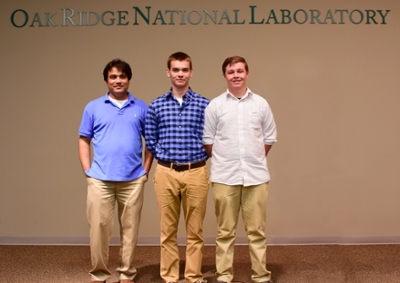 Macromolecules often self-assemble to form natural materials like protein, DNA and also commercial materials like rubber. It is well known that the particles of macromolecules follow Newtonian mechanics at a classical level, i.e., they follow F=ma. Therefore, if we know the force acting on a particle at a given time, we can predict, by using Newtonʼs law, what is going to happen in a future time. For this, we feed the computer with the ʽvirtualʼ macromolecules and instruct the computer to find out the final product following Newtonian mechanics. Hence, the designing of novel polymeric materials on a computer can be achieved.
Macromolecules often self-assemble to form natural materials like protein, DNA and also commercial materials like rubber. It is well known that the particles of macromolecules follow Newtonian mechanics at a classical level, i.e., they follow F=ma. Therefore, if we know the force acting on a particle at a given time, we can predict, by using Newtonʼs law, what is going to happen in a future time. For this, we feed the computer with the ʽvirtualʼ macromolecules and instruct the computer to find out the final product following Newtonian mechanics. Hence, the designing of novel polymeric materials on a computer can be achieved.In this project we will try to understand how the molecules interact using computer simulation. What are the forces that bind them together? Why do they self- assemble in a particular form? What is the temperature and density range that should be used to achieve the best material design?
ORNL Division: Computer Science and Mathematics & Center for Nanophase Material Sciences
Mentor: Monojoy Goswami
Students: Treston Hughes, Miklos Obrusanszki
Heterologous expression of mgsD to identify potential adaptation to salt stress
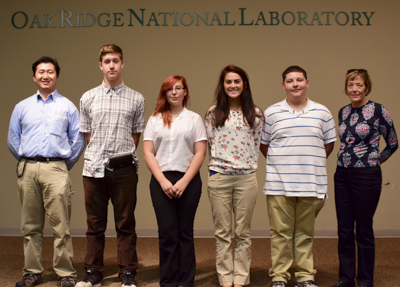 Tetrachloroethene (PCE) and trichloroethene (TCE) are two of the most commonly found groundwater contaminants in the United States. These chlorinated solvent contaminants can be remediated by a genus of bacteria known as the Dehalococcoides. Dehalococcoides have evolved to perform bioremediation of PCE to the environmentally benign ethene through a process called reductive dechlorination. Due to their widespread use in bioremediation activities, it is essential to characterize their physiological capabilities in various types of environments. This project will investigate the physiological effects of the mgsD gene on adapting to salt stress by heterologously expressing this gene of interest in E. coli, either from an autonomously replicating vector or from the chromosome itself. In completing this project, students will perform polymerase chain reaction (PCR), agarose gel electrophoresis and growth curves.
Tetrachloroethene (PCE) and trichloroethene (TCE) are two of the most commonly found groundwater contaminants in the United States. These chlorinated solvent contaminants can be remediated by a genus of bacteria known as the Dehalococcoides. Dehalococcoides have evolved to perform bioremediation of PCE to the environmentally benign ethene through a process called reductive dechlorination. Due to their widespread use in bioremediation activities, it is essential to characterize their physiological capabilities in various types of environments. This project will investigate the physiological effects of the mgsD gene on adapting to salt stress by heterologously expressing this gene of interest in E. coli, either from an autonomously replicating vector or from the chromosome itself. In completing this project, students will perform polymerase chain reaction (PCR), agarose gel electrophoresis and growth curves.ORNL Division: Biosciences Division
Mentors: Nannan Jiang and Frank E. Löffler
Facilitator: Melissa Mynatt
Students: Silas Barr, Matthew Boyd, Dianna Corbett, Kaeley Friel
Magnetic Levitation
 This project will be exploring the principle of magnetic levitation by using a superconducting material. Assembly of a magnetic rail will be conducted to explore the magnetic levitation phenomenon with an oxide-based high Tc superconductor.
This project will be exploring the principle of magnetic levitation by using a superconducting material. Assembly of a magnetic rail will be conducted to explore the magnetic levitation phenomenon with an oxide-based high Tc superconductor.ORNL Division: Materials Science and Technology Division
Mentor: Ho-Nyung Lee
Students: Jenna Clifton, Winzor Guerine, Bennett Watson
Robotic Systems and Engineering Development
 Robots are used in the industry to protect humans from hazardous environments or when the work involves highly repetitive and precision tasks. The objectives of this project are to (1) expose students to robotic projects underway at ORNL and (2) provide hands-on experience in designing, constructing and programming a small robot. The students will work in three groups on similar problems at the Remote Systems Group of ORNL’s Fusion and Materials for Nuclear Systems Division. The focus of this project is to develop the mechanical and programming skills that are needed to design, build and operate a robot. The student will build a robot that can navigate an obstacle course using various sensors (light, ultrasonic and/or touch). The students will learn which sensors are best suited for which purposes and what logic is appropriate for controlling the robot’s trajectory. Students will be using the Lynxmotion Tri-Track Robot and AL5A Robotic Arm for building and testing.
Robots are used in the industry to protect humans from hazardous environments or when the work involves highly repetitive and precision tasks. The objectives of this project are to (1) expose students to robotic projects underway at ORNL and (2) provide hands-on experience in designing, constructing and programming a small robot. The students will work in three groups on similar problems at the Remote Systems Group of ORNL’s Fusion and Materials for Nuclear Systems Division. The focus of this project is to develop the mechanical and programming skills that are needed to design, build and operate a robot. The student will build a robot that can navigate an obstacle course using various sensors (light, ultrasonic and/or touch). The students will learn which sensors are best suited for which purposes and what logic is appropriate for controlling the robot’s trajectory. Students will be using the Lynxmotion Tri-Track Robot and AL5A Robotic Arm for building and testing.ORNL Division: Fusion and Materials for Nuclear Systems
Mentors: Venugopal Varma, Adam Aaron and Adam Carroll
Facilitators: Carl Mallette and Susan Baumann
Students: Reid Artrip, Tessa Brooks, Michael Davis, Jennica England, Dominick Hopper, Caleb Kirschbaum, Logan Knopp, Spencer McNeil, Lawrence Melkulcok, Robert Surge, Caleb Workman
Build a Supercomputer
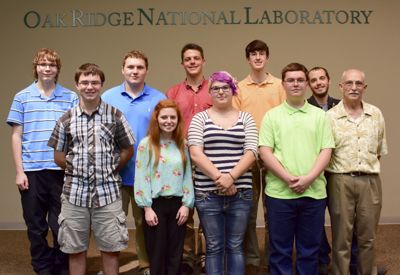 Students will build a supercomputer! Well, almost. Supercomputers typically use thousands of processors running in parallel to solve problems in science, finance, and other areas. They will build a smaller supercomputer to gain insight and understanding in how supercomputers are organized and then how to program them. Students will build a Beowulf cluster using ordinary computers. Students will then write a parallel program, compile the program, and execute that program on the cluster. Areas that will be covered during this project are:
Students will build a supercomputer! Well, almost. Supercomputers typically use thousands of processors running in parallel to solve problems in science, finance, and other areas. They will build a smaller supercomputer to gain insight and understanding in how supercomputers are organized and then how to program them. Students will build a Beowulf cluster using ordinary computers. Students will then write a parallel program, compile the program, and execute that program on the cluster. Areas that will be covered during this project are:- Computing basics
- Computer networking
- Linux operating system
- Computer programming
Project review and summary
Students will be required to answer the research question: "In what year would the supercomputer we build be considered the world's fastest supercomputer?" Students will be given classroom-style lectures in addition to hands-on assignment to enforce topics discussed.
Joint Institute for Computational Sciences
Mentor: Robert Whitten
Facilitator: Jerry Sherrod
Assistants: Benjamin Taylor, Nick Csercsevits, Tommy Hardin
Students: Brien Beattie, Savanna Bell, Hailie Eastburn, Jacob Epstein, Mark Johnson, Thorne Lindsey, Robert Mahiques, Dawson Yost
